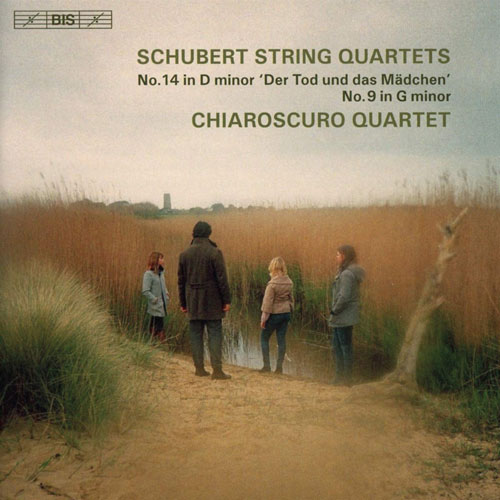SCHUBERT String Quartets, D810 and D173
View record and artist detailsRecord and Artist Details
Composer or Director: Franz Schubert
Genre:
Chamber
Label: BIS
Magazine Review Date: 11/2018
Media Format: Super Audio CD
Media Runtime: 63
Catalogue Number: BIS2268

Tracks:
| Composition | Artist Credit |
|---|---|
| String Quartet No. 14, 'Death and the Maiden' |
Franz Schubert, Composer
Chiaroscuro Franz Schubert, Composer |
| String Quartet No. 9 |
Franz Schubert, Composer
Chiaroscuro Franz Schubert, Composer |
Author: Richard Wigmore
Each of the four movements seems conceived in a single sweep. Even the opening Allegro’s potentially assuaging second theme, usually a cue for momentary relaxation, is caught up in the ongoing tumult; and typically, Alina Ibragimova’s filigree decorations on the theme’s repeat are wonders of delicacy and nuance at speed. After the coda’s truly frantic più mosso, the Chiaroscuro, with their bleak, blanched pianissimo, suggest traumatised exhaustion: Schubert staring into the void.
Crucially, they observe Schubert’s con moto marking for the Andante variations and his request for two rather than (as we often hear) four beats to the bar. In the process a dirge is infused with the grave lilt of a pavan. Again, the movement unfolds with a seemingly inevitable momentum, from the theme itself, where the Chiaroscuro evoke a viol consort, to the flare of violence (properly shocking here) in the final variation. Predictably by now, there is minimal lingering in the cello variation, No 2, and the ethereal major-key variation, No 4. Here and in the first movement, the quartet’s lean sonorities and care for balance (helped by BIS’s exemplary recording) allow Schubert’s knotty rhythmic counterpoint to emerge with ideal clarity.
As an engulfing, visceral experience, the Chiaroscuro’s Death and the Maiden ranks alongside two of my favourite versions, the Alban Berg’s later recording (EMI/Warner, 3/86) and the Gramophone Award-winning Pavel Haas (Supraphon, 10/13). And its astringent ‘period’ sound world puts it in a category of its own. A chasm separates the Death and the Maiden from the 18-year-old Schubert’s G minor Quartet, offered here as a digestif. Parts of the first movement and minuet sound like gawky takes on Haydn and Mozart in Sturm und Drang vein. Yet in a performance as bracingly immediate as this, the work has plenty of enjoyably Schubertian touches, whether in the Andante’s airy dance or the paprika-flavoured finale, duly relished here.
Discover the world's largest classical music catalogue with Presto Music.

Gramophone Digital Club
- Digital Edition
- Digital Archive
- Reviews Database
- Full website access
From £8.75 / month
Subscribe
Gramophone Full Club
- Print Edition
- Digital Edition
- Digital Archive
- Reviews Database
- Full website access
From £11.00 / month
Subscribe
If you are a library, university or other organisation that would be interested in an institutional subscription to Gramophone please click here for further information.




